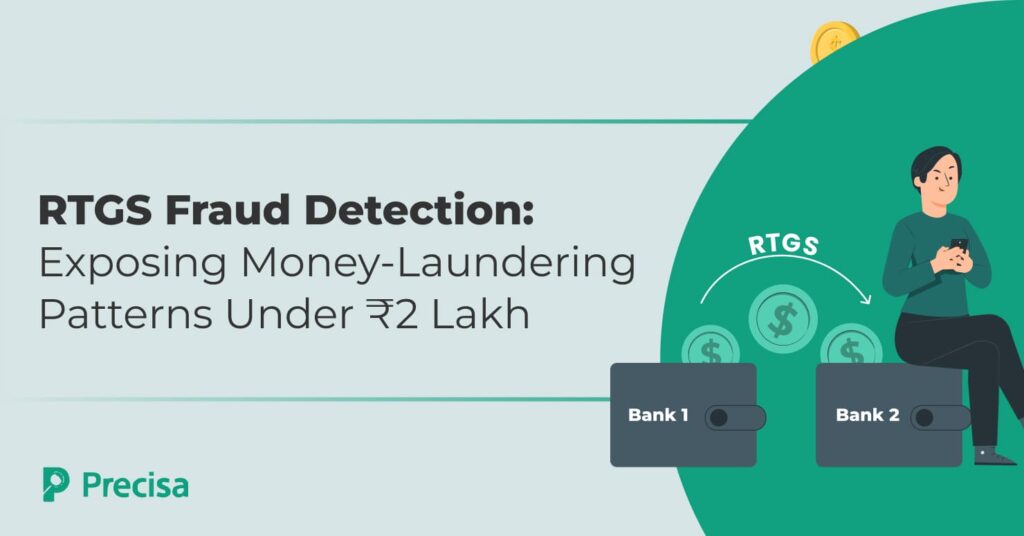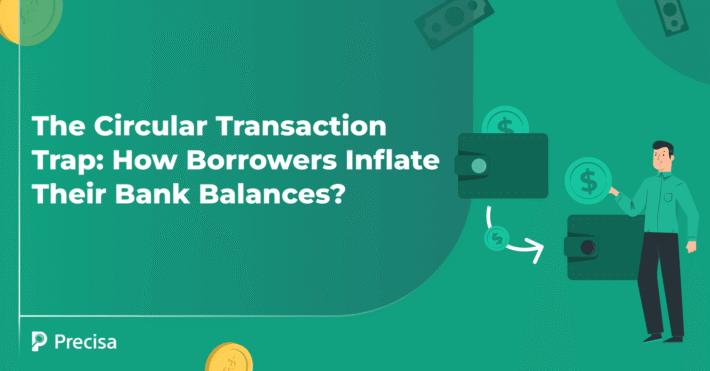RTGS Fraud Detection: Exposing Money Laundering Patterns Under ₹2 Lakh

Designed for high-value, real-time transfers, RTGS transactions are irreversible. Once money leaves an account, recovery is difficult. This means RTGS transactions are a prime target for fraudsters. For instance, in October 2025, a major scam happened in Mumbai. A victim was duped of Rs 58 crore via RTGS into various accounts under the pretext of a law enforcement probe.
This article breaks down how such patterns reveal money-laundering activity and how DSAs, NBFCs, and lenders can use advanced analytics and insights to detect RTGS fraud before it escalates.
RTGS Rules And The Significance Of The ₹2 Lakh Floor
The RBI’s RTGS system is built for high-value transfers. You can only send amounts of ₹2,00,000 or more through RTGS, and once a transaction is processed, it’s final. Since RTGS transfers are irreversible, your bank must verify that the funds are genuine before settlement.
This ₹2 lakh threshold helps separate high-value transfers from everyday retail payments, ensuring faster, more secure fund movement while maintaining control and transparency over large-scale transactions.
Why “Under ₹2 Lakh” Transactions Matter
Fraudsters and money launderers often exploit this ₹2 lakh floor by breaking large sums into smaller payments—a tactic known as structuring or microstructuring.
According to the RBI’s KYC/AML guidelines, if your bank suspects that you’re intentionally splitting transactions below ₹50,000 to avoid detection, it must verify your identity and may file a Suspicious Transaction Report (STR). The same applies if your connected non-account-based transactions total ₹50,000 or more.
These checks exist because criminals deliberately fragment big transfers into smaller ones—an illegal method called smurfing. They then move the money through multiple mule accounts, making it almost impossible to trace. Financial institutions must monitor these patterns systematically. While individual transactions appear insignificant, collectively they reveal sophisticated laundering operations.
RTGS Fraud Detection: Key Red Flags in Payment Patterns
When it comes to RTGS transactions, even detecting the smallest irregularities can reveal the biggest risks. Since RTGS is meant for high-value transfers above ₹2,00,000, any transaction below this limit is an immediate red flag. These out-of-pattern transfers may signal attempts to bypass RBI’s mandated thresholds or hide money movement across accounts.
At Precisa, we’ve built our bank-statement analysis tool to help you spot such anomalies instantly. It highlights RTGS transactions under ₹2 lakh, and rare events that could indicate potential laundering or threshold evasion. But this is just one piece of the puzzle. Our system also flags several other red-flag patterns relevant to DSAs and NBFCs, such as:
- ATM withdrawals above ₹20,000 – Frequent large cash withdrawals can point to unreported income or possible money laundering.
- Cheque deposits on bank holidays – These often signal backdated instruments or suspicious scheduling.
- More cash deposits than salary credits – When cash inflows exceed salary, it could indicate unaccounted income.
- Round-figure tax payments – Genuine tax payments rarely end in neat multiples of ₹100; round figures may be fabricated.
- Equal debits and credits – Matching amounts suggest funds are being circulated to disguise their origin.
- Negative computed balances – Frequent negatives point to financial stress or over-leveraging.
- Immediate large debits after salary credits – Withdrawing 50% or more right after salary credit may reflect undisclosed debts.
- Circular transactions – Back-and-forth transfers between the same accounts often indicate “round-tripping,” a classic laundering technique.
How Do Criminals Exploit RTGS and Small Payments?
As RTGS fraud becomes more sophisticated, criminals are finding new ways to misuse legitimate banking systems:
Microstructuring and Smurfing

As we discussed, criminals often break large sums into many smaller payments. This is called microstructuring. It helps them hide from detection systems. In smurfing, they use multiple mule accounts to move small amounts so that each transaction looks normal.
According to RBI guidelines, if your bank suspects payments below ₹50,000 are being split to avoid detection, it must verify the customer’s identity. This helps prevent criminals from using your accounts for money laundering.
Real-Time Laundering via RTGS
RTGS transactions are instant and cannot be reversed. Fraudsters take advantage of this to move money quickly between accounts.
In one digital-arrest scam, ₹6 crore was transferred through dozens of accounts within minutes. Each transaction looked legitimate but was part of a larger laundering network.
Precisa dashboard helps you find such patterns easily. It shows:
- A Precisa Score (0–1,000) that measures creditworthiness.
- A Volatility Score (0–1) that tracks how stable cash flow is.
- Circular transaction counts that reveal possible layering or round-tripping.
These insights help you identify risks faster and make better lending decisions.
Social-Engineering “Digital Arrest” Scams
In a digital-arrest scam, fraudsters pose as law enforcement officers and trick victims into transferring money voluntarily. Over 100,000 such scams were reported in 2024. Because victims authorise the transfers, traditional fraud systems often miss them.
With Precisa’s behaviour-based analytics, you can monitor real-time transactions, flag coercion-driven transfers, and protect both your customers and your business from fraud.
Using Advanced Analytics to Spot Hidden RTGS Fraud Patterns
Traditional fraud detection systems rely on fixed, rule-based thresholds. They often flag too many false alerts and miss new types of fraud. As fraudsters become more sophisticated, these systems can’t keep up.
A better approach is adaptive, graph-based detection. It looks beyond individual transactions and studies the relationships between accounts, devices, and IP addresses. This helps identify complex fraud networks and multi-hop laundering patterns that static systems usually overlook.
At Precisa, we make this process even more effective. Our bank-statement analysis tool flags unusual transaction patterns like sudden cash spikes, round-tripping, or frequent sub-₹2 lakh transfers.
Final Thoughts
Fraudsters are getting smarter with RTGS and small-value transfers, making it harder for lenders to spot laundering patterns. As DSAs or NBFCs, you need to look beyond rule-based checks and focus on transaction behaviour like repeated round-trips, equal credits and debits, or payments under ₹2 lakh.
With Precisa’s AI-powered bank statement analysis and real-time monitoring, you can uncover hidden risks, strengthen compliance, and make faster, safer lending decisions. We’ve built our bank-statement analysis tool to help you spot such anomalies instantly. Trusted by 1000+ financial institutions across 25+ countries, our platform analyses 1200+ bank formats from 850+ banks.
Contact us today and explore how Precisa helps lenders stay ahead of money-laundering and RTGS fraud attempts.



